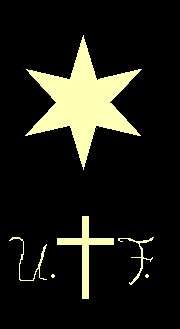Jemima Wilkinson

Jemima Wilkinson (29 November 1752 - July 1, 1819)[1] was a charismatic American evangelist who preached total sexual abstinence and the Ten Commandments to the Quaker "Society of Universal Friends." Wilkinson's family were strict Quakers; most of their views came from their upbringing in the Quaker religion.
Early life and "resurrection"
Wilkinson was the daughter of Amy (née Whipple) and Jeremiah Wilkinson, the cousin of Stephen Hopkins, in Cumberland, Rhode Island. The family attended silent worship with Quakers at the Smithfield Meeting House. As a young person in the mid-1770s, Wilkinson also attended meetings with New Light Baptists.
In 1776, a minor epidemic of typhoid spread throughout Rhode Island, and Wilkinson was infected. This debilitating illness culminated in a fevered state, leaving her bedridden and near death. Upon awakening, Wilkinson claimed to have been sent by God to preach his message. She believed that Christ entered her body during her illness and that she was now neither female nor male.[2] This propelled her to claim that she was "a holy vessel of Jesus Christ and God and the Holy Spirit". Jemima Wilkinson became the "Publick Universal Friend" and never again responded to her original birth name.
Preaching 1777-1790

The year "the Friend" came out, Wilkinson was rejected by her fellow Quaker brethren. Accompanied by several siblings, she began to travel and preach to residents of Rhode Island, Pennsylvania, and Connecticut. During the 1780s, she lived in Worcester and rode a white horse into Philadelphia, PA to preach, where she drew substantial audiences and grew their congregation of "Universal Friends". The Universal Friends were accused of plagiarizing documents authored by members of the Society of Friends, and Wilkinson's personal "seal" may have been adapted from the Quakers. Several Philadelphia newspapers made a special effort to condemn, expose, and discredit Wilkinson's preaching.[3] Being female in the 1700s made the friend a favorite target for libel and slander, but ironically the grandson of their brother Jeptha Wilkinson would later become the inventor of the modern press wheel.[4]
Wilkinson preached a regimen of strict abstinence, and friendship with everyone. She implored all to accept the Fatherhood of God. Many people came to visit her and her followers and were taken in with open arms. Many who came to visit were given all the comforts of home and were only asked to leave if they had done something against the Friends. Michael Bronski writes that by the "mid-1780s the popular press and pamphlet culture covered Wilkinson's sermons in detail and placed particular emphasis on her sexually ambiguous persona. Wilkinson had a huge following that verged on a cult and eventually started a religious settlement in central New York State.[5]"
In March 1790, they began their "group exodus", travelling upstream along the Susquehanna River through present-day Wilkes Barre, PA and Elmira, NY. On 13 April 1790, she and her followers finally reached the north end of Keuka Lake.[6] They named their new township Jerusalem, NY, but it would later be called Penn Yan, NY. She and her followers were the first white people that the Native Americans in this region ever saw and traded with. Wilkinson claimed to have been called "Chief" by the Seneca nation-tribe.
Legacy
The Jemima Wilkinson House is still standing in Jerusalem, New York, on a List of Registered Historic Places in Yates County, New York, located on the same branch of Keuka Lake as the birthplace of Seneca Red Jacket.[7]
Wilkinson was one of the first visionaries of religion and Women's rights in the United States. Their followers pioneered the area between Seneca Lake and Keuka Lake, erecting a grain Mill at present-day Dresden, NY.
References
- ↑ Hudson, David. History of Jemima Wilkinson: a preacheress of the eighteenth century, p. ii APPENDIX, NO II
- ↑ Bronski, Michael (2011). A Queer History of the United States. Xxx: Beacon Press. p. 50. ISBN 0807044652.
- ↑ Wisbey, Herbert A. Jr. Pioneer Prophetess Jemima Wilkinson, the Publick Universal Friend. Cornell University Press.
- ↑ Rev. Israel Wilkinson, 1869 Memoirs of the Wilkinson Family in America
- ↑ Bronski, Michael (2011). A Queer History of the United States. Xxx: Beacon Press. p. 51. ISBN 978-0807044650.
- ↑ Pritchard, Ruth."THE VOICE THAT SPAKE AS NEVER MAN SPAKE" (WILKINSON, JEMIMA.)
- ↑ Davis, Miles Avery. HISTORY OF JERUSALEM.
Further reading
- Hudson, David. History of Jemima Wilkinson: a preacheress of the eighteenth century; containing an authentic narrative of her life and character, and of the rise, progress and conclusion of her ministry (1821). online
- Moyer, Paul B. The Public Universal Friend: Jemima Wilkinson and Religious Enthusiasm in Revolutionary America (Cornell University Press, 2015). xiv, 264 pp.
- Wisbey Jr, Herbert A. Pioneer Prophetess: Jemima Wilkinson, the Publick Universal Friend (Cornell University Press, 2009).
External links
- The Friend's Society Index
- Jemima Wilkinson: Celibacy and the Communal Life, The Re-Incarnation of the Divine in Female Form, 1758-1819.
- Last Will & Testament
- Social roots of the Mormon United Order
- PBS History Detectives episode looks at Incorporation papers for Universal Friends
- Claus Bernet (2002). "Jemima Wilkinson". In Bautz, Traugott. Biographisch-Bibliographisches Kirchenlexikon (BBKL) (in German). 20. Nordhausen: Bautz. cols. 1545–1553. ISBN 3-88309-091-3.